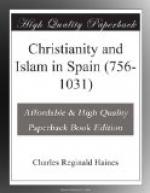On his way to execution, when struck by one of the bystanders on one cheek, he turned the other meekly to the striker. He was beheaded on March 11, 859, and Leocritia four days later. Miraculous appearances honoured the body of the martyred bishop, which was buried in the Church of St Genesius, whence it was translated in the next year to his own church of St Zoilus, and in 883 was given up, together with that of Leocritia, to Alphonso III. (866-910) by express stipulation.
CHAPTER V.
CONTROVERSY CONCERNING THE MARTYRS.
With the death of Eulogius the series of voluntary martyrdoms comes to an end, and it will be convenient at this point to consider the whole question of the relation of the Church to the civil power, and how far those “confessors,” who were put to death under the circumstances already related, were entitled to the name of martyrs. Unfortunately the evidence we have on the subject is drawn almost entirely from the apologists of their doings, and therefore may fairly be suspected of some bias. Yet even from them can be shown conclusively enough that no real persecution was raging in Mohammedan Spain at this time, such as to justify the extreme measures adopted by the party of zealots.
If we except the cases of John and Adulphus, and of Nunilo and Alodia, the date of which is doubtful, there is not a single recorded instance of a Christian being put to death for his religion by the Arabs in Spain before the middle of the ninth century. The Muzarabes,[1] as the Christians living under the Arabs were called, enjoyed a remarkable degree of freedom in the exercise of their religion—the services and rites of the Church being conducted as heretofore.[2] In Cordova alone we find mention of the following churches:[3] the Church of St Acislus, a former martyr of Cordova; of St Zoilus; of the Three Martyrs—Faustus, Januarius, Martialis; of St Cyprian; of SS. Genesius and Eulalia; and of the Virgin Mary.
[1] De Gayangos on Al Makk.,
i. p. 420, says the word means
“those who try to imitate
the Arabs in manners and language.”
[2] Eulog. Letter to Alvar. After the death of Flora he says he spent the ninth hour in prayer, then “auctis tripucliis, vespertinum, matutinum, missale sacrificium consequenter ad honorem (Dei) et gloriam nostrarum virginum celebravimus.”
[3] Florez, x. 245.
Of the last of these there is an interesting account in an Arab writer, who died in 1034.[1] “I once entered at night,” he says, “into the principal Christian Church. I found it all strewed with green branches of myrtle, and planted with cypress trees. The noise of the thundering bells resounded in my ears; the glare of the innumerable lamps dazzled my eyes; the priests, decked in rich silken robes of gay and fanciful colours, and girt with girdle cords, advanced to adore Jesus. Everyone of those present




